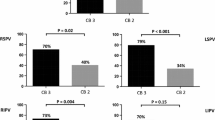Abstract
Purpose
Pulmonary vein isolation (PVI) with the cryoballoon is an established treatment for symptomatic atrial fibrillation. The second-generation cryoballoon increased efficacy in comparison to the first-generation cryoballoon. The third-generation cryoballoon was designed with a shorter distal tip to facilitate real-time recording of pulmonary vein (PV) isolation. Here, we compared the rate of real-time recordings of PVI of the second- and third-generation cryoballoon.
Methods
The incidence of real-time recording of PV isolation and time to PV isolation of the first 37 patients treated with the new third-generation cryoballoon at our center were compared to the last 37 patients treated with the second-generation cryoballoon.
Results
One hundred forty-nine pulmonary veins (PVs) were identified in each group. All PVs were isolated successfully with the second- or third-generation cryoballoon. Real-time registration of PVI occurred in 83 PVs (55.7 %) with the second-generation cryoballoon and in 124 PVs (83.2 %) with the third-generation cryoballoon (p < 0.001). The rate of observed real-time PVI was significantly higher with the third-generation cryoballoon for each individual PV. The time-to-isolation was 44 ± 25 s with the second-generation cryoballoon vs. 42 ± 22 s with the third-generation cryoballoon (p = 0.25). In a short-term clinical follow-up, there was no significant difference in atrial arrhythmia recurrence rates between both groups.
Conclusions
The third-generation cryoballoon facilitates real-time recording of PV isolation with significantly higher rates of observed time-to-isolation. The time to PV isolation is not different between second- and third-generation cryoballoon.



Similar content being viewed by others
References
Kuck KH, Brugada J, Furnkranz A, Metzner A, Ouyang F, Chun KR et al. Cryoballoon or radiofrequency ablation for paroxysmal atrial fibrillation. N Engl J Med 2016;374(23):2235–45.
Luik A, Radzewitz A, Kieser M, Walter M, Bramlage P, Hormann P, et al. Cryoballoon versus open irrigated radiofrequency ablation in patients with paroxysmal atrial fibrillation: The prospective, randomized, controlled, noninferiority freezeAF study. Circulation. 2015;132(14):1311–9.
Packer DL, Kowal RC, Wheelan KR, Irwin JM, Champagne J, Guerra PG, et al. Cryoballoon ablation of pulmonary veins for paroxysmal atrial fibrillation: first results of the North American Arctic Front (STOP AF) pivotal trial. J Am Coll Cardiol. 2013;61(16):1713–23.
Aryana A, Morkoch S, Bailey S, Lim HW, Sara R, d’Avila A, et al. Acute procedural and cryoballoon characteristics from cryoablation of atrial fibrillation using the first- and second-generation cryoballoon: a retrospective comparative study with follow-up outcomes. J Interv Card Electrophysiol. 2014;41(2):177–86.
Aytemir K, Gurses KM, Yalcin MU, Kocyigit D, Dural M, Evranos B, et al. Safety and efficacy outcomes in patients undergoing pulmonary vein isolation with second-generation cryoballoondagger. Europace. 2015;17(3):379–87.
Chierchia GB, Di Giovanni G, Ciconte G, de Asmundis C, Conte G, Sieira-Moret J, et al. Second-generation cryoballoon ablation for paroxysmal atrial fibrillation: 1-year follow-up. Europace. 2014;16(5):639–44.
Di Giovanni G, Wauters K, Chierchia GB, Sieira J, Levinstein M, Conte G, et al. One-year follow-up after single procedure Cryoballoon ablation: a comparison between the first and second generation balloon. J Cardiovasc Electrophysiol. 2014;25(8):834–9.
Furnkranz A, Bordignon S, Dugo D, Perotta L, Gunawardene M, Schulte-Hahn B, et al. Improved 1-year clinical success rate of pulmonary vein isolation with the second-generation cryoballoon in patients with paroxysmal atrial fibrillation. J Cardiovasc Electrophysiol. 2014;25(8):840–4.
Jourda F, Providencia R, Marijon E, Bouzeman A, Hireche H, Khoueiry Z, et al. Contact-force guided radiofrequency vs. second-generation balloon cryotherapy for pulmonary vein isolation in patients with paroxysmal atrial fibrillation-a prospective evaluation. Europace. 2015;17(2):225–31.
Metzner A, Reissmann B, Rausch P, Mathew S, Wohlmuth P, Tilz R, et al. One-year clinical outcome after pulmonary vein isolation using the second-generation 28-mm cryoballoon. Circ Arrhythm Electrophysiol. 2014;7(2):288–92.
Pandya B, Sheikh A, Spagnola J, Bekheit S, Lafferty J, Kowalski M. Safety and efficacy of second-generation versus first-generation cryoballoons for treatment of atrial fibrillation: a meta-analysis of current evidence. J Interv Card Electrophysiol. 2016;45(1):49–56.
Aryana A, Mugnai G, Singh SM, Pujara DK, de Asmundis C, Singh SK, et al. Procedural and biophysical indicators of durable pulmonary vein isolation during cryoballoon ablation of atrial fibrillation. Heart Rhythm. 2016;13(2):424–32.
Ciconte G, Mugnai G, Sieira J, Velagic V, Saitoh Y, Irfan G, et al. On the quest for the best freeze: predictors of late pulmonary vein reconnections after second-generation cryoballoon ablation. Circ Arrhythm Electrophysiol. 2015;8(6):1359–65.
Ciconte G, Velagic V, Mugnai G, Saitoh Y, Irfan G, Hunuk B, et al. Electrophysiological findings following pulmonary vein isolation using radiofrequency catheter guided by contact-force and second-generation cryoballoon: lessons from repeat ablation procedures. Europace. 2016;18(1):71–7.
Lakhani M, Saiful F, Parikh V, Goyal N, Bekheit S, Kowalski M. Recordings of diaphragmatic electromyograms during cryoballoon ablation for atrial fibrillation accurately predict phrenic nerve injury. Heart Rhythm. 2014;11(3):369–74.
Mondesert B, Andrade JG, Khairy P, Guerra PG, Dyrda K, Macle L, et al. Clinical experience with a novel electromyographic approach to preventing phrenic nerve injury during cryoballoon ablation in atrial fibrillation. Circ Arrhythm Electrophysiol. 2014;7(4):605–11.
Furnkranz A, Bologna F, Bordignon S, Perrotta L, Dugo D, Schmidt B, Chun JK. Procedural characteristics of pulmonary vein isolation using the novel third-generation cryoballoon. Europace. 2016, [Epub ahead of print].
Heeger CH, Wissner E, Mathew S, Hayashi K, Sohns C, Reissmann B et al. Short tip-big difference? First-in-man experience and procedural efficacy of pulmonary vein isolation using the third-generation cryoballoon. Clin Res Cardiol. 2015;105(6):482–8.
Mugnai G, de Asmundis C, Hunuk B, Stroker E, Moran D, Hacioglu E et al. Improved visualisation of real-time recordings during third generation cryoballoon ablation: a comparison between the novel short-tip and the second generation device. J Interv Card Electrophysiol. 2016, [Epub ahead of print].
Author information
Authors and Affiliations
Corresponding author
Ethics declarations
Funding sources
None
Disclosures
T. Dahme received speaker’s honoraria from Medtronic. The other authors have no conflicts to report.
Rights and permissions
About this article
Cite this article
Pott, A., Petscher, K., Messemer, M. et al. Increased rate of observed real-time pulmonary vein isolation with third-generation short-tip cryoballoon. J Interv Card Electrophysiol 47, 333–339 (2016). https://doi.org/10.1007/s10840-016-0160-3
Received:
Accepted:
Published:
Issue Date:
DOI: https://doi.org/10.1007/s10840-016-0160-3




